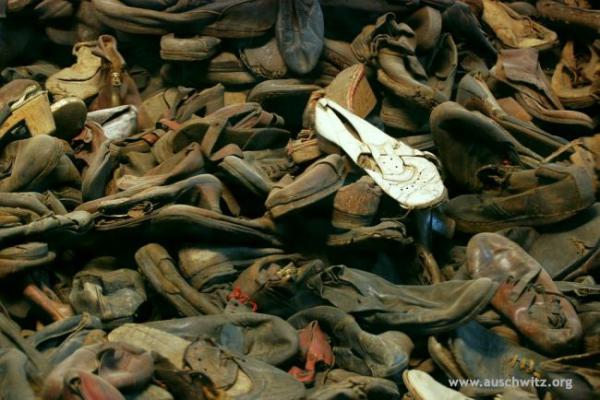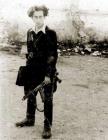די רעדער יאָגן, יאָגן
וואָס ברענגען זיי מיט זיך?
זיי ברענגען מיר אַ וואָגן
מיט צאַפּלענדיקע שיך.
דער וואָגן ווי אַ חופּה
אין אָוונטיקן גלאַנץ
די שיך — אַ פֿולע קופּע
ווי מענטשן אין אַ טאַנץ
אַ חתונה, אַ יום-טוב ?
צי האָט מיך ווער פֿאַרבלענדט?
די שיך — אַזוינע נאָענטע
אויף ס’נײַ איך האָב דערקענט.
עס קלאַפּן די אָפּצאַסן:
וווּהין, וווּהין, וווּהין?
פֿון אַלטע ווילנער גאַסן
מע טרײַבט אונדז קיין בערלין.
איך דאַרף ניט פֿרעגן וועמעס
נאָר ס’טוט אין האַרץ אַ ריס :
אָ, זאָגט מיר, שיך, דעם אמת ,
וווּ זענען זיי די פֿיס?
די פֿיס פֿון יענע טופֿל
מיט קנעפּלעך ווי טוי,
און דאָ — וווּ איז דאָס גופֿל,
און דאָרט וווּ איז די פֿרוי?
אין קינדערשיך אין אַלע
וואָס זע איך ניט קיין קינד?
וואָס טוט ניט אָן די כּלה
די שיכעלעך אַצינד ?
דורך קינדערשיך און שקראַבעס
כ’דערקען מײַן מאַמעס שיך!
זי פֿלעגט זיי בלויז אויף שבת
אַרויפֿציִען אויף זיך.
און ס’קלאַפּן די אָפּצאַסן:
וווּהין, וווּהין, וווּהין?
פֿון אַלטע ווילנער גאַסן
מע טרײַבט אונדז קיין בערלין.
וואָס ברענגען זיי מיט זיך?
זיי ברענגען מיר אַ וואָגן
מיט צאַפּלענדיקע שיך.
דער וואָגן ווי אַ חופּה
אין אָוונטיקן גלאַנץ
די שיך — אַ פֿולע קופּע
ווי מענטשן אין אַ טאַנץ
אַ חתונה, אַ יום-טוב ?
צי האָט מיך ווער פֿאַרבלענדט?
די שיך — אַזוינע נאָענטע
אויף ס’נײַ איך האָב דערקענט.
עס קלאַפּן די אָפּצאַסן:
וווּהין, וווּהין, וווּהין?
פֿון אַלטע ווילנער גאַסן
מע טרײַבט אונדז קיין בערלין.
איך דאַרף ניט פֿרעגן וועמעס
נאָר ס’טוט אין האַרץ אַ ריס :
אָ, זאָגט מיר, שיך, דעם אמת ,
וווּ זענען זיי די פֿיס?
די פֿיס פֿון יענע טופֿל
מיט קנעפּלעך ווי טוי,
און דאָ — וווּ איז דאָס גופֿל,
און דאָרט וווּ איז די פֿרוי?
אין קינדערשיך אין אַלע
וואָס זע איך ניט קיין קינד?
וואָס טוט ניט אָן די כּלה
די שיכעלעך אַצינד ?
דורך קינדערשיך און שקראַבעס
כ’דערקען מײַן מאַמעס שיך!
זי פֿלעגט זיי בלויז אויף שבת
אַרויפֿציִען אויף זיך.
און ס’קלאַפּן די אָפּצאַסן:
וווּהין, וווּהין, וווּהין?
פֿון אַלטע ווילנער גאַסן
מע טרײַבט אונדז קיין בערלין.
inviata da Bernart Bartleby - 18/2/2014 - 11:23
Lingua: Yiddish
In Yiddish traslitterato, da Sam Yiddish Site Web
(Mi pare che la traslitterazione sia ben poco tedeschizzante: vedo “kh” e “v”, “z” e “sh”, “der” e “y” e “f”…)


(Mi pare che la traslitterazione sia ben poco tedeschizzante: vedo “kh” e “v”, “z” e “sh”, “der” e “y” e “f”…)

auschwitz.org, foto di Paweł Sawicki.

auschwitz.org, foto di Paweł Sawicki.
A VOGN SHIKH
Di reder yogn, yogn
Vos brengen zey mit zikh?
Zey brengen mir a vogn
Mit tsaplendike shikh
Der vogn vi a khupe
In oventikn glants
Di shikh- a fule kupe
Vi mentshn in a tants
A khasene, a yontev?
Tsi hor mikh ver farblendt?
Di shikh-azoyne noente
Oyf s’nay ikh hob derkent.
Es klapn di optsasn :
Vuhin? Vuhin? Vuhin?
Fun alte vilner gasn
Me traybt undz keyn Berlin.
Ikh darf nisht fregn vemes
Nor s’tut in hartz a ris:
O zogt mir shikh, dem emes,
Vu zenen zey di fis?
Di fis fun yene tufl
Mit kneplekh vi toy,
Un do-vu iz dos gufl,
Un dort vu iz di froy?
In kindershikh in ale
Vos ze ikh nit keyn kind?
Vos tut nit on di kale
Di shikhelekh atsind?
Durkh kindershikh un shkrabes
Kh’derken mayn mames shikh!
Zi flegt zey bloyz oyf shabes
Aroyftsien oyf zikh
Un s’klapn di optsasn:
Vuhin? Vuhin? Vuhin?
Fun alte vilner gasn
Me traybt undz keyn Berlin.
Di reder yogn, yogn
Vos brengen zey mit zikh?
Zey brengen mir a vogn
Mit tsaplendike shikh
Der vogn vi a khupe
In oventikn glants
Di shikh- a fule kupe
Vi mentshn in a tants
A khasene, a yontev?
Tsi hor mikh ver farblendt?
Di shikh-azoyne noente
Oyf s’nay ikh hob derkent.
Es klapn di optsasn :
Vuhin? Vuhin? Vuhin?
Fun alte vilner gasn
Me traybt undz keyn Berlin.
Ikh darf nisht fregn vemes
Nor s’tut in hartz a ris:
O zogt mir shikh, dem emes,
Vu zenen zey di fis?
Di fis fun yene tufl
Mit kneplekh vi toy,
Un do-vu iz dos gufl,
Un dort vu iz di froy?
In kindershikh in ale
Vos ze ikh nit keyn kind?
Vos tut nit on di kale
Di shikhelekh atsind?
Durkh kindershikh un shkrabes
Kh’derken mayn mames shikh!
Zi flegt zey bloyz oyf shabes
Aroyftsien oyf zikh
Un s’klapn di optsasn:
Vuhin? Vuhin? Vuhin?
Fun alte vilner gasn
Me traybt undz keyn Berlin.
inviata da Bernart Bartleby - 18/2/2014 - 11:27
Lingua: Inglese
Traduzione inglese dall’E-book collection dell’Università della California
A WAGON OF SHOES
The wheels they drag and drag on,
What do they bring, and whose?
They bring along a wagon
Filled with throbbing shoes.
The wagon like a khupa [*]
In evening glow, enchants:
The shoes piled up and heaped up,
Like people in a dance.
A holiday, a wedding?
As dazzling as a ball!
The shoes — familiar, spreading,
I recognize them all.
The heels tap with no malice:
Where do they pull us in?
From ancient Vilna alleys,
They drive us to Berlin.
I must not ask you whose,
My heart, it skips a beat:
Tell me the truth, oh, shoes,
Where disappeared the feet?
The feet of pumps so shoddy,
With buttondrops like dew —
Where is the little body?
Where is the woman too?
All children's shoes — but where
Are all the children's feet?
Why does the bride not wear
Her shoes so bright and neat?
'Mid clogs and children's sandals,
My Mama's shoes I see!
On Sabbath, like the candles,
She'd put them on in glee.
The heels tap with no malice:
Where do they pull us in?
From ancient Vilna alleys,
They drive us to Berlin.
The wheels they drag and drag on,
What do they bring, and whose?
They bring along a wagon
Filled with throbbing shoes.
The wagon like a khupa [*]
In evening glow, enchants:
The shoes piled up and heaped up,
Like people in a dance.
A holiday, a wedding?
As dazzling as a ball!
The shoes — familiar, spreading,
I recognize them all.
The heels tap with no malice:
Where do they pull us in?
From ancient Vilna alleys,
They drive us to Berlin.
I must not ask you whose,
My heart, it skips a beat:
Tell me the truth, oh, shoes,
Where disappeared the feet?
The feet of pumps so shoddy,
With buttondrops like dew —
Where is the little body?
Where is the woman too?
All children's shoes — but where
Are all the children's feet?
Why does the bride not wear
Her shoes so bright and neat?
'Mid clogs and children's sandals,
My Mama's shoes I see!
On Sabbath, like the candles,
She'd put them on in glee.
The heels tap with no malice:
Where do they pull us in?
From ancient Vilna alleys,
They drive us to Berlin.
inviata da Bernart Bartleby - 18/2/2014 - 11:28
Nota: [*] Khupa, chuppah, huppah, chupah, chuppa (ebraico: חוּפָּה) è la tenda, il baldacchino tradizionale ebraico sotto il quale sta la coppia di sposi durante la cerimonia nuziale.
Bernart Bartleby - 18/2/2014 - 11:28
La trascrizione è perfetta; vedi che ti stai cominciando a impratichire. Non è difficile e non è necessario che tu conosca lo yiddish, basta applicare i criteri "visivi" che ti ho specificato...
Riccardo Venturi - 18/2/2014 - 12:43
Riccardo, com'è andata 'sta volta? (destra-sinistra a parte che, come dice Renzie/Fonzie, sono ormai categorie del tutto superate...)
Bernart Bartleby - 18/2/2014 - 13:49
Okkei, e quindi restiamo intesi che se invece avvisto qualche tedesco, do subito l'allarme e attendo ordini (cazzo, mi sembra di essere nella foresta intorno a Vilnius alla fine del 43...)
Bernart Bartleby - 18/2/2014 - 13:54
Bello, mi piace quest'atmosfera da lotta partigiana antinazista! E l'hanno a vedere 'sti crucchi maledetti, che prima hanno sterminato una lingua intera e poi pretendono pure di trascriverla a modo loro. No pasarán! Anche se, va detto, la colpa è parecchio spesso di certi cantanti e cantantesse klezmer regolarmente americani/e. Ma non tutti/e sono Moni Ovadia, che lo yiddish lo conosce per davvero (sospetto anzi che, essendo nato in Bulgaria, sia la sua lingua materna). A proposito di Bulgaria, e vedendoti in forma particolarmente smagliante: che ne diresti di cercare anche qualche canzone in "ladino" (non quello della Val Gardena, il giudeo-spagnolo o "judezmo" dico)?...
Riccardo Venturi - 18/2/2014 - 14:58
Ehhhh, mo' vediamo, neh! A 'sto giro c'ho già da fare il turno di guardia, che con quei maledetti נאַציס in giro bisogna stare all'occhio...
Bernart Bartleby - 18/2/2014 - 15:17
×
![]()

![Avrom Sutskever [Abraham Sutzkever] / אברהם סוצקעװער Avrom Sutskever [Abraham Sutzkever] / אברהם סוצקעװער](img/art/t2065630.jpg?1543485902)






[1 gennaio 1943]
Versi di Avrom Sutskever
Musica di Tomáš Novotný
Interpretata da Hilda Bronstein nel suo disco “Yiddish Songs Old and New”. Il testo si trova recitato dallo stesso autore in un vecchio disco della Folkways Records.
Testo trovato sul blog Sam Yiddish Site Web
In questa sua famosa poesia Avrom Sutskever riesce a sintetizzare magistralmente tutto l’orrore dell’Olocausto attraverso l’immagine di un carro che attraversa cigolando i vicoli silenti del ghetto di Vilnius, carico di scarpe ancora palpitanti della vita di chi le calzava, tutti ebrei morti di stenti nella prigione a cielo aperto in cui i nazisti li rinchiusero… In soli due anni, dal settembre 1941 al settembre 1943, la fame, le malattie, le esecuzioni sommarie uccisero quasi tutti i 40.000 ebrei rinchiusi nel ghetto lituano. Sopravvissero solo coloro che, come Sutskever e la moglie , riuscirono a fuggire (insieme a Shmerke Kaczerginski e Abba Kovner), unendosi poi ai partigiani.